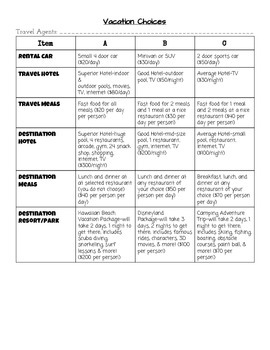Plan a Vacation! Math Project
Voytko's Variety
22 Followers
Grade Levels
3rd - 4th
Subjects
Standards
CCSS3.MD.A.1
CCSS3.NBT.A.2
CCSS3.NBT.A.3
CCSS3.OA.A.2
CCSS3.OA.A.3
Formats Included
- PDF
Voytko's Variety
22 Followers
Description
Students pretend to be travel agents as they work in pairs to plan a vacation for a family of four with a budget of $5,000. Students will first watch an introduction presentation to learn about their tasks. They will then receive a Vacation Choices board with which to plan the details of the trip, a Vacation Costs sheet to calculate totals, and a rubric to guide the process. After planning the vacation, students will present their information to their "clients" in the form of a PowerPoint, brochure, or poster. The project allows students to practice multiplication, addition, subtraction, elapsed time, and multi-step problems while fostering creativity and critical thinking skills.
Total Pages
Answer Key
N/A
Teaching Duration
N/A
Report this resource to TPT
Reported resources will be reviewed by our team. Report this resource to let us know if this resource violates TPT’s content guidelines.
Standards
to see state-specific standards (only available in the US).
CCSS3.MD.A.1
Tell and write time to the nearest minute and measure time intervals in minutes. Solve word problems involving addition and subtraction of time intervals in minutes, e.g., by representing the problem on a number line diagram.
CCSS3.NBT.A.2
Fluently add and subtract within 1000 using strategies and algorithms based on place value, properties of operations, and/or the relationship between addition and subtraction.
CCSS3.NBT.A.3
Multiply one-digit whole numbers by multiples of 10 in the range 10–90 (e.g., 9 × 80, 5 × 60) using strategies based on place value and properties of operations.
CCSS3.OA.A.2
Interpret whole-number quotients of whole numbers, e.g., interpret 56 ÷ 8 as the number of objects in each share when 56 objects are partitioned equally into 8 shares, or as a number of shares when 56 objects are partitioned into equal shares of 8 objects each. For example, describe a context in which a number of shares or a number of groups can be expressed as 56 ÷ 8.
CCSS3.OA.A.3
Use multiplication and division within 100 to solve word problems in situations involving equal groups, arrays, and measurement quantities, e.g., by using drawings and equations with a symbol for the unknown number to represent the problem.





